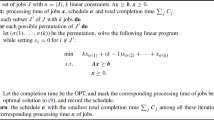Abstract
This paper presents the results of computational studies of the properties of cutting plane algorithms as applied to posynomial geometric programs. The four cutting planes studied represent the gradient method of Kelley and an extension to develop tangential cuts; the geometric inequality of Duffin and an extension to generate several cuts at each iteration. As a result of over 200 problem solutions, we will draw conclusions regarding the effectiveness of acceleration procedures, feasible and infeasible starting point, and the effect of the initial bounds on the variables. As a result of these experiments, certain cutting plane methods are seen to be attractive means of solving large scale geometric programs.
Similar content being viewed by others
References
M. Avriel, R. Dembo and U. Passy, “Solution of generalized geometric programs”,International Journal for Numerical Methods in Engineering 9 (1975) 149–168. Also presented by R. Dembo at the 41st TIMS Meeting, Houston, Texas (April 1972).
M. Avriel and A.C. Williams, “Complementary geometric programming”,SIAM Journal on Applied Mathematics 19 (1970) 125–146.
P.A. Beck and J.G. Ecker, “Some computational experience with a modified convex simplex algorithm for geometric programs”, Report ADTC-12-20, Rensselaer Polytechnic Institute, Troy, New York, 1972; andJournal of Optimization Theory and Application 15 (1975) 189–202.
A. Ben-Tal and A. Ben-Israel, “Primal geometric programs treated by linear programming”, Research Report CCS187, Center for Cybernetic Studies, University of Texas (July 1974).
A. Charnes and W.W. Cooper,Management models and industrial application of linear programming, Volume I, II (Wiley, New York, 1961).
E.W. Cheney and A.A. Goldstein, “Newton's method of convex programming and Tchebycheff approximation”,Numerische Mathematik 1 (1959) 253–268.
R.J. Clasen, “Using linear programming as a simplex subroutine”, Rand Corp. Memo P-3267, November 1965 (SHARE Distribution Agency No. 3884).
J.J. Dinkel, W.H. Elliott and G.A. Kochenberger, “A linear programming approach to geometric programs”,Naval Research Logistics Quarterly (to appear).
J.J. Dinkel, G.A. Kochenberger and B. McCarl, “An approach to numerical solutions of geometric programs”,Mathematical Programming 7 (1974) 181–190.
R.J. Duffin, “Linearizing geometric programs”,SIAM Review 12 (1970) 211–227.
R.J. Duffin, E.L. Peterson and C. Zener,Geometric programming — theory and applications (Wiley, New York, 1967).
B.C. Eaves and W.I. Zangwill, “Generalized cutting plane algorithms”,SIAM Journal on Control 9 (1971) 529–542.
W.H. Elliott, “Primal geometric programs treated by sequential linear programming”, Ph.D. Thesis, The Pennsylvania State University (1976).
J. Elzinga and T.G. Moore, “A central cutting plane algorithm for the convex programming problem”,Mathematical Programming 8 (1975) 134–145.
C.J. Frank, “An algorithm for geometric programming”, in: A. Lani and T.P. Vogl, eds.,Recent advances in optimization techniques (Wiley, New York, 1965).
A.M. Geoffrion, “Elements of large-scale mathematical programming”,Management Science 16 (1970) 652–691.
H.O. Hartley and R.R. Hocking, “Convex programming by tangential approximation”,Management Science 9 (1963) 600–612.
D.M. Himmelblau,Applied nonlinear programming (McGraw-Hill, New York, 1972).
J.E. Kelley, “The cutting plane method for solving convex programs”,SIAM Journal on Applied Mathematics 8 (1960) 703–712.
D.G. Luenberger,Introduction to linear and nonlinear programming (Addison-Wesley, Reading, MA, 1973).
D.M. Topkis, “Cutting plane methods without nested constraint sets”,Operations Research 18 (1970) 404–413.
D.M. Topkis, “A note on cutting plane methods without nested constraint sets”,Operations Research 18 (1970) 1216–1220.
A.F. Veinott, “The supporting hyperplane method for unimodal programming”,Operations Research 15 (1967) 147–152.
P. Wolfe, “Accelerating the cutting plane method for nonlinear programming”,SIAM Journal on Applied Mathematics 9 (1961) 481–488.
W.I. Zangwell,Nonlinear programming: a unified approach (Prentice-Hall, Englewood Cliffs, NJ 1969).
J.G. Ecker and M.J. Zoracki, “An easy primal method for geometric programming”,Management Science 23 (1976) 71–77.
M.J. Rijckaert and X.M. Martens, “A condensation method for generalized geometric programming”,Mathematical Programming 11 (1976) 89–93.
Author information
Authors and Affiliations
Additional information
This author's research was supported in part by the Center for the Study of Environmental Policy, The Pennsylvania State University.
Rights and permissions
About this article
Cite this article
Dinkel, J.J., Elliott, W.H. & Kochenberger, G.A. Computational aspects of cutting-plane algorithms for geometric programming problems. Mathematical Programming 13, 200–220 (1977). https://doi.org/10.1007/BF01584337
Received:
Revised:
Issue Date:
DOI: https://doi.org/10.1007/BF01584337




